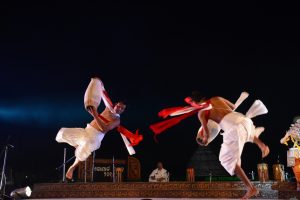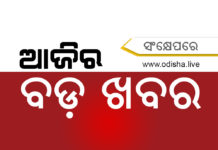Kapilas Bhuyan
The origin and journey of ‘Konark Festival’ that has been organised since 1989 in the backdrop of Sun temple of Konark
As December sets in with its smooth cold breeze, the small tourist town Konark becomes a vibrating place and the year-long waiting for the Konark Festival comes to an end. While at one hand the world class dancers adorn the huge stage in the backdrop of the world famous Konark Sun Temple, on the other international sand artists come up with their sand sculptures on the beaches of Chandrabhaga, where a now vanished river bed that connects the Bay of Bengal.
 The calendar is constant; from 1st to 5th December every year, at dateline Konark. This has been a trend ever since its inception in 1989.
The calendar is constant; from 1st to 5th December every year, at dateline Konark. This has been a trend ever since its inception in 1989.
However, in the early phase the festival used to be for 3 days, and later on it got extended to five days. Earlier it was only a festival of dance, and on the sidelines the International Sand Art Festival was a later add-on in 2011. But the response to the sand art festival has been tremendous both by the participants from foreign countries as well as by the viewers.
 Have there been any plausible changes of Konark Festival over last twenty-five years or so?
Have there been any plausible changes of Konark Festival over last twenty-five years or so?
“In the initial phase the Konark Dance Festival was designed for only the presentation of solo and duet performances, and thus, the stage was made as according to that. However, with the love and adoration of people it has subsequently grown into Konark Festival”, recounts Sangeeta Gosain, the Chief Excutive of Guru Kelucharan Mohapatra Odisi Research Centre (GKMORC).
 On the other hand Ileana Citaristi, the eminent Odisi danseuse having adored with the Padmshri says, “I think there have not been that many transformations in the Konarka Festival along the years. The format has remained more or less the same with 5 evening of Odissi dance alternating with dance group performances from other styles of classical dances (with the constant presence of Odissi Research Centre either for the opening or the closing). The real asset has been that the festival has been able to keep the same dates from 1st to 5th of December all along the years, so it has established itself as a recurrent event in all tourist circuit”.
On the other hand Ileana Citaristi, the eminent Odisi danseuse having adored with the Padmshri says, “I think there have not been that many transformations in the Konarka Festival along the years. The format has remained more or less the same with 5 evening of Odissi dance alternating with dance group performances from other styles of classical dances (with the constant presence of Odissi Research Centre either for the opening or the closing). The real asset has been that the festival has been able to keep the same dates from 1st to 5th of December all along the years, so it has established itself as a recurrent event in all tourist circuit”.
“Over the years we can see how Konark Festival has transformed into a significant culture ‘brand’ of Odisha. Through the Festival, Odisha is able to position itself as a ‘must-see’ tourist destination of India where one is able to partake in a major dance event in a world famous archeological site – Konark. The Festival has abled to combine two major cultural attractions – i.e. Dance (particularly odissi) and Konark.
Presently, audiences are given an added bonus that they are also able to experience other classical dance styles. The added live telecast has now increased its viewership and prestige as an event of international stature”, opines eminent Odisi dancer and Guru from Malaysia Ramli Ibrahim.
 In the early phase of the Konark Festival the response had been lukewarm as all dancers at that time mostly preferring to be invited to the oldest Khajuraho dance festival. But the table has turned now. Over since last half-decade or so, when Mr. Ashok Kumar Tripathy had taken the baton as the Secretary of Dept. of Culture to conduct the festival, he left no stone unturned to organize it in the best possible manner.
In the early phase of the Konark Festival the response had been lukewarm as all dancers at that time mostly preferring to be invited to the oldest Khajuraho dance festival. But the table has turned now. Over since last half-decade or so, when Mr. Ashok Kumar Tripathy had taken the baton as the Secretary of Dept. of Culture to conduct the festival, he left no stone unturned to organize it in the best possible manner.
Starting from the selection of top notch dance ensembles to live-streaming the performances gave the Konark Festival its much awaited push to become the most important dance festival, not only inside but outside the country too. This also has ensured the simultaneous viewership of performances worldwide. Today various Indian-dance ensembles have a dream to come and dance in the Konark Festival.
 “As you know Odisi dance is not limited to India alone. It has spread its wings world over, particularly in countries like USA, Germany, France, Russia, Singapore, Japan, Malaysia and Bangladesh a lot of dancers are learning and practicing Odisi. They dream to come and dance here in Konark Festival as it is the most famous one today”, says the eminent Odisi dance Guru Ratikanta Mohapatra.
“As you know Odisi dance is not limited to India alone. It has spread its wings world over, particularly in countries like USA, Germany, France, Russia, Singapore, Japan, Malaysia and Bangladesh a lot of dancers are learning and practicing Odisi. They dream to come and dance here in Konark Festival as it is the most famous one today”, says the eminent Odisi dance Guru Ratikanta Mohapatra.
Sangeeta Gosain endorses the fame of Konark Festival by saying that she has attended many dance festivals, but as she perceives today that all other festivals have been lagging behind. “Konark Festival started after Khajuraho, Elora and Hampi festivals, but today it has gone much ahead of all of them as it has showcased the most famous dancers over the years”, says Sangeeta Gosain.
“I think the reputation of the Konarka Dance Festival among the dancers and dance lovers is quite good, almost at par with the Khajuraho one, which have been the pioneer in the field of Dance Festivals organized in places of architectural importance. Payment to artists also is adequate and all facilities are provided in an adequate way. The big responsibility is to keep up the high quality of performances each year, and this depends on the members of the selection committee”, opines Ileana Citaristi.
 With almost the same tone Ramli Ibrahim expresses his view, “Due to the effective marketing from Odisha Tourism, Konark Festival has emerged a winner in popularity if compared to the various other festivals, which are also exploiting their archeological sites as tourist attractions. I think with the opening of Bhubaneswar as a direct international destination, this will be an even added advantage. Odisha Tourism must quickly take on this lead over the other sites.”
With almost the same tone Ramli Ibrahim expresses his view, “Due to the effective marketing from Odisha Tourism, Konark Festival has emerged a winner in popularity if compared to the various other festivals, which are also exploiting their archeological sites as tourist attractions. I think with the opening of Bhubaneswar as a direct international destination, this will be an even added advantage. Odisha Tourism must quickly take on this lead over the other sites.”
How can the Konark Festival improve its stature and importance?
“Bigger does not necessarily be better. Konark Festival has to constantly be on its toes to sustain excellent standards in organizational matters pertaining to administrative and artistic content.
Konark town planning itself has to improve and be attractive. As for the content, how the five-day Festival is curated, is of paramount importance. Audience have to be satisfied as they have value for money and invited artistes (national and international) from the different groups should also concur that Konark Festival is a unique dance platform. It has to be the cultural destination – not only for audiences but also for artistes to pay homage to this iconic dance venue and then go home and convince others as well, to come to Konark”, suggests Ramli Ibrahim.
“More and more digital interface of the Konark Festival will surely make it a world class festival”, opines Sangeeta Gosain.
 “I think the pre-publicity of the Festival should be improved; often I have been asked ‘who is performing this year?’, ‘when is the festival?’ and ‘ where one can stay?’ by people who are not able to find a well informative website in the net which would give precise information well ahead of time”, says Ileana Citaristi.
“I think the pre-publicity of the Festival should be improved; often I have been asked ‘who is performing this year?’, ‘when is the festival?’ and ‘ where one can stay?’ by people who are not able to find a well informative website in the net which would give precise information well ahead of time”, says Ileana Citaristi.
“We have taken steps as to how more and more viewers will attend this year’s Konark Festival. For this we have put up hoardings at different places and in the social media sites of our dept. we have publicized a lot”, says Dr. Nitin Bhanudas Jawale, the Director of Tourism Dept., Govt. of Odisha.
“The tourist inflow over last one and half decade has gone manifold. Visitors take much interest to move around Bhubaneswar, Puri and Konark, the Golden Triangle. But unlike Puri and Bhubaneswar, there is not much infrastructure facilitation in Konark. Commuting from Bhubaneswar every evening to witness the Konark Festival is a little cumbersome. It’s time to develop proper infrastructure in Konark which will contribute a lot for tourist inflow round the year, and also improve the stature of the festival”, says Ratikanta Mohapatra.
 Almost same is the opinion of Ramli Ibrahim. He says, “I think as the major annual cultural destination, Konark Festival has positioned itself well, but the Festival can even be more successful as an international tourist destination if it has good middle-range hotels and restaurants in Konark itself to cater for foreign tourists. After all, they have come especially to see this festival. As the venue-space is huge, group works with spectacular choreography tend to be more effective from the audience point of view and this vantage has influenced how dance composition is now being approached in Odisha itself.”
Almost same is the opinion of Ramli Ibrahim. He says, “I think as the major annual cultural destination, Konark Festival has positioned itself well, but the Festival can even be more successful as an international tourist destination if it has good middle-range hotels and restaurants in Konark itself to cater for foreign tourists. After all, they have come especially to see this festival. As the venue-space is huge, group works with spectacular choreography tend to be more effective from the audience point of view and this vantage has influenced how dance composition is now being approached in Odisha itself.”
(The Writer is a Senior Journalist and National Award Winning Film Maker)

















